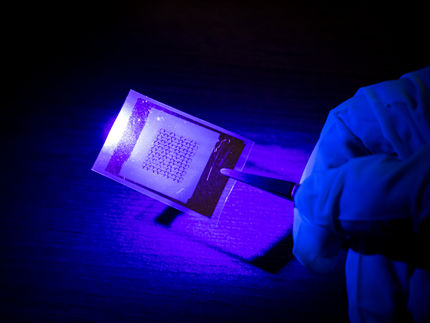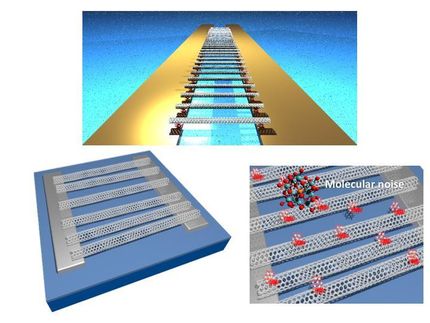New sensor array detects single molecules for the first time
Carbon nanotube sensor detects hydrogen peroxide emanating from a single living cell
MIT chemical engineers have built a sensor array that, for the first time, can detect single molecules of hydrogen peroxide emanating from a single living cell. Hydrogen peroxide has long been known to damage cells and their DNA, but scientists have recently uncovered evidence that points to a more beneficial role: it appears to act as a signaling molecule in a critical cell pathway that stimulates growth, among other functions.
When that pathway goes awry, cells can become cancerous, so understanding hydrogen peroxide's role could lead to new targets for potential cancer drugs, says Michael Strano, leader of the research team. Strano and his colleagues describe their new sensor array, which is made of carbon nanotubes, in Nature Nanotechnology .
Strano's team used the array to study the flux of hydrogen peroxide that occurs when a common growth factor called EGF activates its target, a receptor known as EGFR, located on cell surfaces. For the first time, the team showed that hydrogen peroxide levels more than double when EGFR is activated.
EGF and other growth factors induce cells to grow or divide through a complex cascade of reactions inside the cell. It's still unclear exactly how hydrogen peroxide affects this process, but Strano speculates that it may somehow amplify the EGFR signal, reinforcing the message to the cell. Because hydrogen peroxide is a small molecule that doesn't diffuse far (about 200 nanometers), the signal would be limited to the cell where it was produced.
The team also found that in skin cancer cells, believed to have overactive EGFR activity, the hydrogen peroxide flux was 10 times greater than in normal cells. Because of that dramatic difference, Strano believes this technology could be useful in building diagnostic devices for some types of cancer.
"You could envision a small handheld device, for example, which your doctor could point at some tissue in a minimally invasive manner and tell if this pathway is corrupted," he says.
Strano points out that this is the first time an array of sensors with single-molecule specificity has ever been demonstrated. He and his colleagues derived mathematically that such an array can distinguish "near field" molecular generation from that which takes place far from the sensor surface. "Arrays of this type have the ability to distinguish, for example, if single molecules are coming from an enzyme located on the cell surface, or from deep within the cell," says Strano.
Original publication: Hong Jin, Daniel Heller, Marie Kalbacova, Jong-Ho Kim, Jingqing Zhang, Ardemis Boghossian, Narendra Maheshri, Michael Strano; "Detection of single-molecule H2O2 signaling from epidermal growth factor receptor using fluorescent single-walled carbon nanotubes"; Nature Nanotechnology 2010.
Most read news
Topics
Organizations
Other news from the department science

Get the analytics and lab tech industry in your inbox
By submitting this form you agree that LUMITOS AG will send you the newsletter(s) selected above by email. Your data will not be passed on to third parties. Your data will be stored and processed in accordance with our data protection regulations. LUMITOS may contact you by email for the purpose of advertising or market and opinion surveys. You can revoke your consent at any time without giving reasons to LUMITOS AG, Ernst-Augustin-Str. 2, 12489 Berlin, Germany or by e-mail at revoke@lumitos.com with effect for the future. In addition, each email contains a link to unsubscribe from the corresponding newsletter.



























































